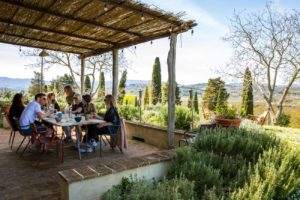 Shine Holistic brings you The Regeneration Retreat 2023 in Umbria, Italy with Rehana Kapadia
Shine Holistic brings you The Regeneration Retreat 2023 in Umbria, Italy with Rehana Kapadia
As a cranial osteopath and naturopath, I have been part of the original Shine Holistic health team since 2004 and very much looking forward to our second year of the REGENERATION RETREAT retreat.
Working collaboratively with Shine’s nutritionist Michelle McKenzie and therapeutic massage therapist, Becky Norton, has allowed us to pool our knowledge and skills, in our shared commitment to achieving optimal health for you.
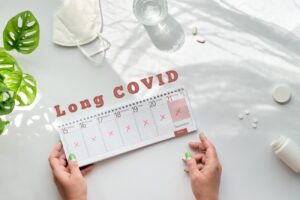 Like Michelle, I too, contracted covid-19, very early on in the pandemic – before testing was available – and then went on the unexpected rollercoaster of months of long covid symptoms such as burning sore throat, tight heavy chest, racing heart, neurological symptoms, brain fog and extreme fatigue, which would remit and then re-surface. I know that I was very fortunate, in many ways, that I was able to draw deep, into my clinical osteopathic knowledge and naturopathic resources, to recover fully.
Like Michelle, I too, contracted covid-19, very early on in the pandemic – before testing was available – and then went on the unexpected rollercoaster of months of long covid symptoms such as burning sore throat, tight heavy chest, racing heart, neurological symptoms, brain fog and extreme fatigue, which would remit and then re-surface. I know that I was very fortunate, in many ways, that I was able to draw deep, into my clinical osteopathic knowledge and naturopathic resources, to recover fully.
This personal experience and my research, over the last three years, have provided me with invaluable insights into Long Covid and other chronic or systemic illness, that I have been using in my osteopathic practice and bring to the retreat.
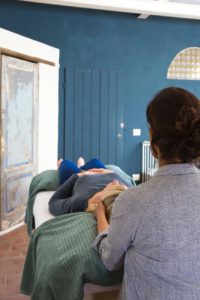 WHAT IS CRANIAL OSTEOPATHY?
WHAT IS CRANIAL OSTEOPATHY?
The practice of cranial osteopathy is a gentle manual therapy, which can belie the deeper philosophical and clinical knowledge.
Osteopathy is rooted in Dr A.T. Still’s practice from 1899. ‘Cranial’ osteopathy is on the subtle spectrum, developed by WG Sutherland, a student of Dr Still.
Osteopaths are regulated primary care practitioners, trained medically, to assess, diagnose, formulate a prognosis and treat any range of health issues. We are also able to make medical referrals for further investigations, as needed.
The principles of osteopathy are based on the interplay, between structure and function of the body: how the body responds to and is shaped by, its internal and external environments.
Osteopathy is neither a series of techniques nor purely biomechanical. It is a philosophy of health. One of the fundamental principles accepted in osteopathy is that “the living body” has an innate intelligence or “inner physician”. The biological process of homeostasis, accepts that the body is constantly working to maintain our optimum level of health. So, with sufficient vitality, the body is self-correcting, self-regulating, self-healing.
The body’s health is expressed through motion.
Our structures are moved voluntarily through our muscular skeletal system and involuntarily in cellular motion, circulation, gut and brain function, nerve transmission and the breath.
At times of stress, injury or illness, the body may struggle to re-balance itself and this can lead to pain and general dysfunction.
Whilst we place value on vital medical procedures and draw on orthodox medical knowledge, such as anatomy, embryology, neurology and pharmacology, osteopaths have additional and differing perspectives on how to manage, treat and maintain our overall health.
Rather than suppress or treat only the symptoms, the key to osteopathy is to look to the cause. By assessing each person individually, osteopaths treat the person, not the ‘disease’.
We take a case history, including the presenting and past status of physical and emotional health, examine the structures for balance, tone, tissue quality and motion and make a diagnosis.
We work by placing skilled, perceptive hands on the body, including the head, for quiet listening. Our ‘thinking’ and ‘listening’ hands are able to assess the quality of health in that person.
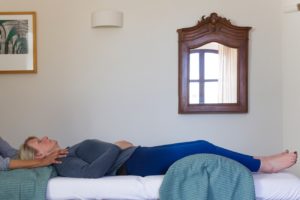 We use our knowledge of anatomy, eg. the route of a nerve, the attachment points of a muscle or ligament, the fascial links in the abdominal organs – to build an internal ‘anatomical picture’ of the patient.
We use our knowledge of anatomy, eg. the route of a nerve, the attachment points of a muscle or ligament, the fascial links in the abdominal organs – to build an internal ‘anatomical picture’ of the patient.
Sensitive refined palpation, allows us to assess areas of the body, where they may be restriction, congestion or inflammation. By using the body structures to access the underlying health of the person, osteopaths aim to improve the circulation and drainage of blood and lymph and encourage good nerve supply pathways to all areas of the body. Thereby, restoring the freedom, the body needs, to get on with its innate capacity to self-heal.
PATTERNS OF HEALTH AND ILLNESS
A mildly unwell person can usually still function, without much noticeable change – this is due to healthy physiological compensation. The impact of viral loads, or other illness, can vary.
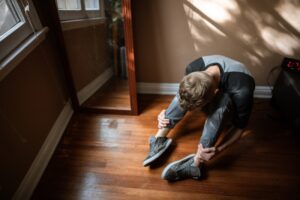 Covid is multi-systemic, affecting the immune system, nervous system, cardio-vascular, gastric, musculo-skeletal systems, as well as our psychological and emotional health. The adaptations the body makes to combat chronic illness, such as Long Covid, can lead to a multitude of structural findings. A person slow to recover from illness is thought to display irregular or ‘failed compensation’ in the body – leaving the person unable to function adequately. Dysfunctional systems leave a person exhausted.
Covid is multi-systemic, affecting the immune system, nervous system, cardio-vascular, gastric, musculo-skeletal systems, as well as our psychological and emotional health. The adaptations the body makes to combat chronic illness, such as Long Covid, can lead to a multitude of structural findings. A person slow to recover from illness is thought to display irregular or ‘failed compensation’ in the body – leaving the person unable to function adequately. Dysfunctional systems leave a person exhausted.
LONG COVID THEORIES
1. Pattern of systemic inflammation involving high Interleukins –a ‘cytokine storm’
2. Virus enters ACE2 receptors and dysregulates metabolic system.
The Renin-Angiotensin-Aldosterone system (hormones and enzymes) involving the kidneys, liver, lungs, blood vessels, adrenals, pituitary, hypothalamus all contribute to regulate normal blood pressure, volume, vascular tone and electrolyte balance.
3. Autonomic dysregulation: ANS = Sympathetic (SNS) + Parasympathetic (PNS).
ACE 1 – affects SNS – pro-inflammatory part of the autonomic nervous system
ACE II – PNS / vagus – anti-inflammatory control in autonomics
This key balance in the Autonomic Nervous System is disrupted by covid.
4. Viral Persistence or viral remnants trigger in small bowel and associated symptoms.
5. Mast cell activation syndrome (MCAS) causes hyper-inflammation
6. Post viral fatigue syndrome – systemic inflammation; hyperactive immune response
7. Endocrine dysfunction – affecting the hypothalamus, glands and nervous system.
8. Exacerbation of existing intolerances/ deficiencies
9. Mental health issues: Depression, chronic anxiety
OSTEOPATHS LOOK FOR HEALTH WITHIN THE DYNAMIC BODY
Cranial Osteopaths, with our trained hands, can assess functional or dysfunctional patterns: Eg: Congestion in the pelvis can be a sign of sluggish lymphatic flow and lower immune function.
We can de-pressurise this system via osteopathic treatment in key areas containing lymph nodes eg. the cavities in behind the knees, underarms, sternum, cubital elbow fossae and lifting the pectoral girdle. We can release any strains in the sacrum or lumbar spine and encourage lymphatic drainage into the major cisterna chylii lymphatic duct at the level of L1 and L2.
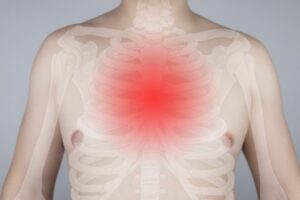 A very stiff thoracic spine may restrict rib attachments and the function of the corresponding chain of sympathetic nerves, which run along the ribs heads and supply our organs. Decompressing the spine to alleviate pressure on the nerves, can lead to improved function of the associated organs.
A very stiff thoracic spine may restrict rib attachments and the function of the corresponding chain of sympathetic nerves, which run along the ribs heads and supply our organs. Decompressing the spine to alleviate pressure on the nerves, can lead to improved function of the associated organs.
Inflammation and stress
The vagus nerve has a myriad of functions in calming the breath, heart-rate and digestive function. As the longest nerve in the body, it emerges from the head to the neck, thorax and into the gut. We can work osteopathically to alleviate any compromise along the nerve pathway, by gently releasing restrictions, at the base of the skull: site of the jugular foramen where the nerve emerges, and at the splenic flexure: in the bowel/abdomen, where it ends, to encourage auto-regulation.
Such is the information we gather, that allows the osteopath to make connections between listening to the narrative of the person telling their story and listening to the ‘narrative’ of the health history we feel and ‘read’ in the body.
Psychosomatic theory gives us insight into how short and long-term emotional stress impacts on the body.
Naturopathic training outlines the biochemistry of the body, optimal nutrition and dietetics.
Rehana’s Training and Background
Rehana Kapadia BA (Hons), MA, BSc (Hons) Ost Med, MSc Paediatric Ost, DO, ND, MSCC
Rehana completed her four-year BSc hons degree in Osteopathic Medicine, with a Diploma in Naturopathy from the British College of Osteopathic Medicine (formerly British College of Osteopathy and Naturopathy), accredited by the University of Westminster. She has a postgraduate MSc degree in Paediatric Osteopathy, with two-year clinic training at the OCC (Osteopathic Centre for Children), including experience in Neonate intensive care units at Barnet Hospital and the North Middlesex Hospital.
Her professional development is ongoing, with postgraduate training at the Sutherland Cranial College, Biodynamic Traditional Osteopathy and Bowlby’s Attachment-based psychotherapy. She is member of the Sutherland Cranial College (MSCC) and the Institute of Osteopathy (iO). Rehana has practiced within the NHS and taught final year undergraduates at the British College of Osteopathic Medicine (BCOM). She has two private practices in N7 and N16.
Rehana is a fully insured and Registered osteopath with (GOsC) the General Osteopathic Council.Osteopaths are primary care practitioners, regulated by Statue and governed by the GOsC.
· General Osteopathic Council: https://www.osteopathy.org.uk
· Member of Sutherland Cranial College: https://scco.ac/
· Member of the Institute of Osteopathy: https://www.iosteopathy.org
· Alumni member of the Foundation for Paediatric Osteopathy: https://www.fpo.org.uk
I very much look forward to working, restoring and resting together in the hills of Umbria/Tuscany with you and the Shine Team.
Rehana


